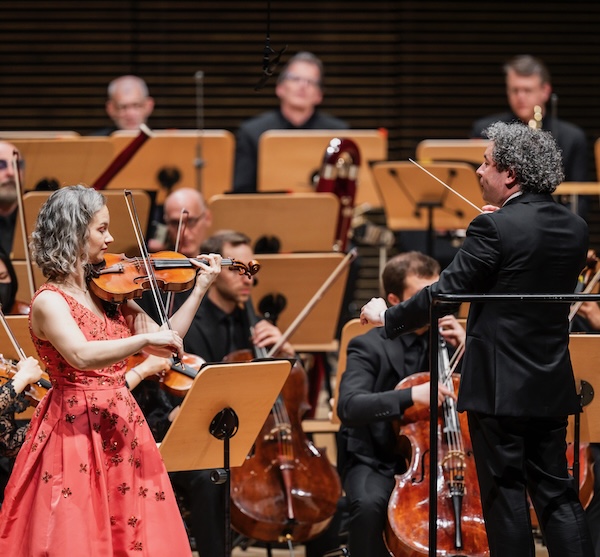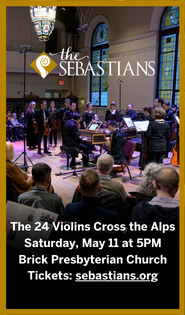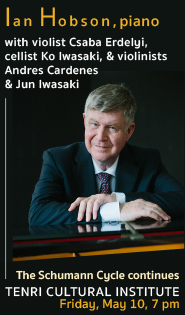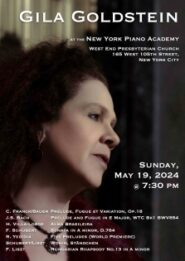Dudamel takes the reins for Philharmonic’s mixed “Spanish” program

Serendipitously, future New York Philharmonic music director Gustavo Dudamel took the podium Thursday night at David Geffen Hall. Juanjo Mena was the scheduled guest conductor for this week’s program, but fell ill, and Dudamel was fortuitously available—in town to lead a special concert of high school musicians—and already familiar with half the music.
The concert was focused on two other things, though, violin soloist Hilary Hahn and the program’s theme of music from or about Spain. Opening and closing with Ravel—Rapsodie espagnole and Boléro—the middle of the evening was all Hahn, who played Alberto Ginastera’s Concerto for Violin and Orchestra to close the first half, and opened the second with Pablo de Sarasote’s Concerto Fantasy on Motifs from Bizet’s Opera Carmen (Debussy’s Iberia, originally scheduled, was cut).
The thematic unity was less than met the eye; Ravel was French, inspired by Spain, and Ginastera was Argentinian. Stylistically, he was also the odd man out, his mid-20ᵗʰ century modernism something of a misfit with the rest pod the music.
Ravel was a tough act to follow to begin with. The beauty, elegance, wit, strength, sensualism, and intellect of his music is an endless treat, and Thursday night’s performances were mostly excellent. They were also another step in the developing picture of the orchestra. Even playing in what is essentially a new hall in a transitional era, the Philharmonic has become a great orchestra for impressionist composers.
With Dudamel conducting from memory, the orchestra opened Rapsodie espagnole with a marvelous level of quiet, more a presence than specific pitches, and the music grew from there. Balances were exquisite, layers of instrumental color that were both distinct and blended. The style and articulation of phases was superb. The only flaw came from the podium with sequences of ritards in “Prelude to Night” and “Festival” that came to the precipice of bogging down without maintaining any sense of tension. Still, this was a gorgeous and energetic performance.
Ginastera’s Violin Concerto is an interesting part of the Philharmonic’s history. The orchestra commissioned the work and Ruggiero Ricci played it with Leonard Bernstein conducting at the inaugural opening concert of Lincoln Center in 1963. There have been no performances since then until Thursday. Despite Hahn’s usual powerful musical presence, it was easy to see why.
There have been fitful efforts over the past ten years or so to revive Ginastera’s reputation, but his work is rarely top quality— specific to a time in musical and cultural history, and largely artifactual in nature. He was part of a small mid-century movement to mix serial techniques with expressionist tonality, the kind of thing that Alban Berg did so well, but then he was Alban Berg. The concerto is a turgid cul-de-sac of involuted psychological angst and formal capriciousness.
Still, Hahn threw her all into it. Her technique was towering, from getting an enormous, tactile grain out of the E string to her unerring intonation and articulation of a long, melodic passage entirely in legato double-stops. But not even Hahn’s down-to-earth humanity could rescue this piece from itself.
The Carmen Concerto Fantasy was naturally right in her wheelhouse, and also that of the orchestra and the audience. Hahn skipped through the vocal lines with elan, playing the ornamental features and using rubato with great naturalism. She played around with different kinds of articulation in a way that was spontaneous and fun, and Dudamel and the orchestra met that spirit with the feeling of a big band relishing playing tasty music together.
This deserved the multiple ovations to follow, and Hahn played an encore of the Loure from Bach’s solo violin Partita No. 3. No one on the scene plays Bach like Hahn, and her ease with the music, the sense of beauty and of sharing a private experience, was the deepest point of the concert.
The high mark came with the final chord of Boléro. As with the first piece, the phenomenal quiet from the Philharmonic at the start was a thing of beauty in itself, although a mass coughing attack from the audience obscured almost all the playing until the first instrumental solo. With that, the audience started listening, and heard a performance that had an interesting roughness to it, a swaggering flow, even with some of the solos coming off as rhythmically stiff. The trombone and piccolo added a loose, slightly tipsy feeling, and that elevated it all to a very satisfying finish.
The program will be repeated 8 p.m. Friday and Saturday. nyphil.org






Posted Apr 26, 2024 at 5:19 pm by DIANE M SANDOVAL
Ravel was Basque, born and died in the part of Basque Country (straddling the Spanish French border) that became part of France. Another composer on the program, Sarasate, also was born in Basque Country. There was nothing representing Southern Spain on the program.
Posted Apr 27, 2024 at 11:43 am by Joseph
Rather a harsh pronouncement. I found the concerto nearly every bit as thrilling as Berg, especially in the hands of Ms. Hahn. The dynamics of a live performance do overwhelm the solo violin in spots–her “Eclipse” recording is more balanced,–but overall one of my most treasured concert experiences in a decade.
Posted Apr 28, 2024 at 10:49 am by Peter Aretin
The Dude abides.